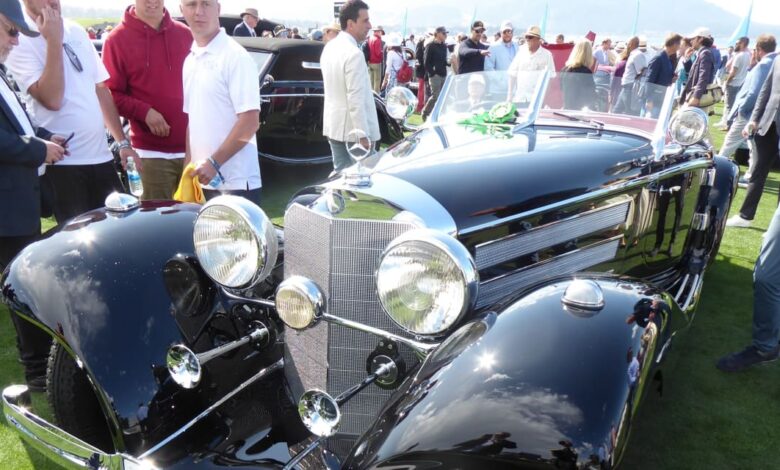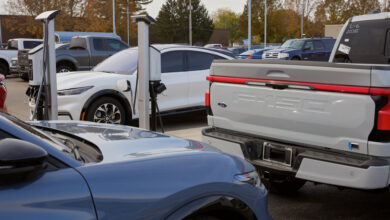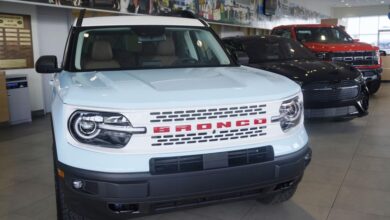Check out the Spectacular Automobiles at Monterey Car Week

The Rolex-sponsored Pebble Beach Tour d’Elegance at Monterey Car Week involves more than 150 of the world’s most exclusive automobiles in a procession along 17-Mile Drive around the peninsula to Big Sur. The weather was near perfect for the annual event held Thursday, and so was the chosen car—a 1956 Bentley S1 Continental drophead (convertible) with body by Park Ward. The Bentley is one of 58 right drivers; just 31 were built in left-hand drive.
Owner David Wilkie, an Australian lawyer, inherited the S1 from his father, an enthusiast of the marque. The car was shipped from Australia to England in 2019 for a three-year restoration by firm P&A Wood. From there, it came straight to Pebble, and the Tour was the one of its first drives since the work was done.
The newly upholstered leather seats were incredibly luxurious and the car, powered by a 4.9-liter straight six-cylinder engine, was near silent. It just wafted along. Or at least it did until the engine suddenly died, after which we coasted to a stop—the rest of the tour whizzing past. Attempting to flag down other drivers didn’t work—they thought we were waving. Fortunately, Wilkie had imported the car’s P&A steward over from London, and he arrived with an adjustable wrench, diagnosed a fuel pressure problem, and soon had the Bentley back on the road to complete the event.
Also taking place during Car Week, the Quail, a Motorsports Gathering, is like no other car show, combining high-end cars—many of them supercars for 2023—with gourmet food stations, dogs, music, and a dress-up day. Held at the Quail Lodge and Golf Club in Carmel, Calif., it was founded by Gordon McCall 20 years ago and, as he told Penta, “a complement to what goes on at Car Week—an event as much about people as about cars. What’s fun is that we have hundreds of millions worth of cars here, but we also have more modest cars with heart and soul such as—this year—a Triumph Spitfire, but one with quite a story behind it.”
There was a range of new model introductions at the Quail. Bernard Loire, chief commercial officer at Maserati, brought out the 730-horsepower MC20 Extrema, and pitched it as “the most powerful track-only Maserati ever made.” The car’s Nettuno V-6 is “pushed to its maximum—the gloves are off,” Loire said during a news conference. Only 62 will be produced, and they’re already sold out.
Advertisement – Scroll to Continue
Czinger unveiled the 1,350-horsepower Blackbird edition of its 21C supercar, inspired by the exceptionally fast Lockheed SR-71 Blackbird spy plane (capable of exceeding Mach 3). “They were inventing a new type of propulsion system,” says Kevin Czinger, who runs the namesake operation (a pioneer in 3-D manufacturing, alongside sister company Divergent) with his son, Lukas. “This car reflects that kind of effort,” Czinger says. “Do that, and form follows function. What we’re doing reflects an absolute transformation from analog to full-digital manufacturing.”
Ford showed the 2025 Mustang GTD, which will go on sale next year starting at US$300,000. It’s a street car—all carbon fiber except for the aluminum doors—that will help Ford go back to Le Mans in 2024 with the GT3 and try to beat Ferrari once again. The GTD has a track four inches wider than a standard Mustang. It was designed in a “tin shack” off site, and has a targeted 800 horsepower from a supercharged 5.2-liter V-8 engine.
The GTD also can boast of an eight-speed dual-clutch transmission, a dry sump to prevent oil starvation, and 50-50-weight distribution. Semi-active suspension is an option. One racer goal is to get around the Nürburgring track in less than seven minutes.
Advertisement – Scroll to Continue
“We needed to do a race car and then a street car for homologation, but this time we did them side by side,” says Jim Owens, marketing manager for the Mustang, tells Penta.
Jim Farley, CEO of Ford, adds that “the tech in it is kind of crazy, but it’s the pinnacle of Mustang.”
Lamborghini’s Lanzador is a radical-looking SUV to join the Urus—the company’s current sales leader. Rouven Moir, the chief technology officer, says that the show car is “very close” to the actual production vehicle, which will be Lamborghini’s fourth model. The car sits high, like an SUV should, but Moir says, “if you cut off the wheels, what you’ll see is more or less a super sports car. It’s a GT that gives the people what they want—a long roof, a high seating position, and more ground clearance.” He says that adding SUVs to the lineup brings in “a lot of customers who hadn’t previously considered Lamborghini.”
Advertisement – Scroll to Continue
Rolls-Royce brought a customer car called La Rose Noire, a “droptail” convertible that incorporates 1,603 hand-finished wood pieces plus a wearable Audemars Piguet Royal Oak Concept clock/watch, and is a one of one. The price wasn’t disclosed, but the Coachbuilds are very exclusive automobiles. There will be three more unique cars in the series. Volkswagen offered something more mainstream: the three-row ID.Buzz intended for the American market.
The Rolex Monterey Motorsports Reunion, held at WeatherTech Laguna Seca, is a chance to see cars previously glimpsed only on static display take to the track in anger—more than 400 cars in 14 classes. The noise is deafening and the action intense, as cars from the 1920s forward compete. Ford brought the GTD, and GM celebrated 70 years of the Corvette with a display that included many historic racers—including the 1960 Cunningham team cars that scored the first class win for the brand at Le Mans.
And then there was the 72nd Pebble Beach Concours itself, a fixture on the Monterey Peninsula since 1950. The day starts with the “Dawn Patrol” at around 5:30 a.m. Enthusiasts brave the morning mists and chillier temperatures to watch the cars come in, headlights blazing and engines making deep, lumpy thrum-thrums as their exhaust perfumes the air. These old cars occasionally break down here, too, in their moment of greatest glory.
As the day brightens and warms, the field laid out on the 18th fairway of the Pebble Beach golf course becomes clearer. For 2023, some notable categories included cars from the flamboyant French Figoni & Falaschi coachbuilders, and American dream cars (mostly fiberglass) from the 1950s. Of the latter, the 1952 Maverick Sportster—billed back then as the “world’s largest fiberglass-bodied car”—was particularly impressive, the result of 1,189 hours of hand work by California designer H. Sterling “Smoke” Gladwin Jr.
Best in show was the supercharged 1937 Mercedes-Benz 540K Special Roadster belonging to Louisville, Kentucky’s Jim Patterson—and built for Mohammed Zahir Shah, then the king of Afghanistan. A best-in-class winner was Peter and Merle Mullin’s bright red 1939 Delahaye Type 165 Figoni & Falaschi cabriolet that was a New York World’s Fair show car that year. Because the European war broke out, the Delahaye—a glorious Art Deco statement—got separated from its intended engine. A Cadillac V-8 sat in the engine bay as the streamlined beauty suffered one indignity after another in the postwar years. At one point, the car was sold to a tow-truck operator for US$1,200. It finally washed up derelict in a California garage. A complete restoration that included, finally, reunion with the original V-12 racing engine followed the car’s rediscovery in the late 1980s.
Advertisement – Scroll to Continue
Of course, there were many auctions associated with Monterey Car Week. Sotheby’s Motorsport debuted with the online auction of a spectacular Ferrari SF90 Spider, followed by its first group of supercars. According to Hagerty, more than 1,200 vehicles (150 of them more than US$1 million) were sold across five auctions, bringing in a total of US$396.7 million with a sell-through rate of 68%. That was down a bit from the US$473 million in 2022, with a 78% sell-through. The market is cooling, but not dramatically so.
On the show field, cars that stood out included a 1953 Cadillac Ghia Coupe—one of two built, and a perfect marriage of Italian design and American V-8 muscle. A 1912 Simplex 50 HP stood out for its sheer size and huge brass Solarclypse lamps. A 1910 Pope Hartford Model T Touring was similar, and evidence of Hartford, Connecticut’s brief bid to become America’s Detroit. The row of Spanish Pegasos was impressive, and each of the Z-102s (and one Z-103) was substantially different. A 1929 Duesenberg J Murphy Dual-Cowl Phaeton was delivered new to the founder of Radio City Music Hall.
Of course, there were also armies of exquisite Packards, Bugattis, and Ferraris. Special classes celebrated anniversaries for McLaren, Lamborghini, and Porsche.



